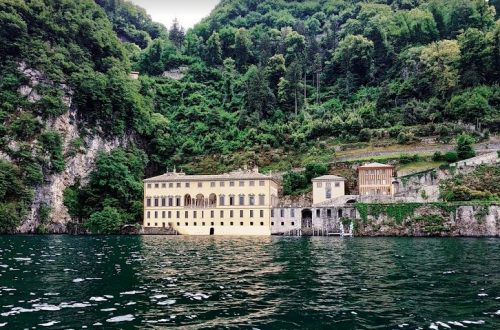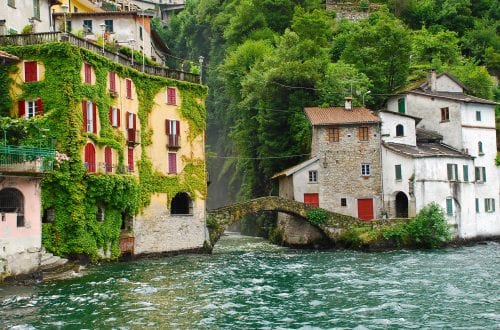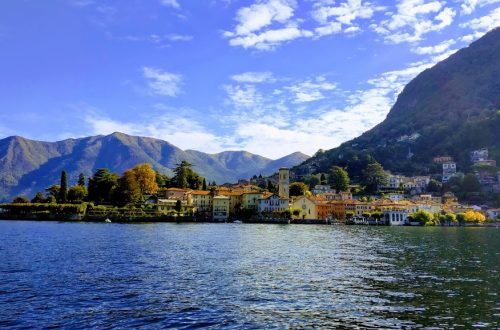
Lecco, the Other Side of Como Lake
Lecco is a historic city where water and rock blend in a timeless embrace. It sits at the tip of the eastern branch of Lake Como. While less well-known than the city that gives the lake its name, Lecco gained fame thanks to Alessandro Manzoni, who set his most famous novel, The Betrothed, here.
Stretched along the water, Lecco lies where the Adda River becomes a lake. It’s a pleasant place to relax, walk, and enjoy the natural beauty that surrounds it. The elegant old town, right on the lakeshore, tells the story of a city made immortal by Manzoni’s words.
Lecco is a beautiful city, though it often remains in the shadow of rival Como. Its charm is of a different kind—more modest, perhaps, and that’s what I’ve always loved about it.
The lakeside promenade is enclosed by mountains, and the climate feels almost alpine, with strong winds sweeping through. I always remind myself to dress warmly when I visit.
Lecco is more rustic than Como, but also more genuine. That’s why I enjoy spending weekends here. Even in winter, the evenings are lively. People gather in the wind-sheltered piazza, chatting and admiring the snow-covered mountains. Come and see for yourself!
A Glimpse of History
Lecco has a complex history. Once part of the Duchy of Milan under the Visconti family, it later fell under Spanish and then Austrian rule. These different periods left behind a rich cultural and artistic heritage, with monuments, churches, and gardens that are still significant attractions today.
The city can be explored in a day, although its surroundings offer plenty of reasons to stay longer—between the lake shores and the mountains.
Azzone Visconti Bridge
Lecco is accessible via several bridges over the Adda River. The main one is Azzone Visconti Bridge, commonly known as the “Old Bridge” due to its age. Built in the 14th century for military purposes, it still plays a key role in the city’s road network.
At night, the bridge is especially charming. You can admire its 18 illuminated arches from the lakeside promenade, glowing over the waters—sometimes calm, sometimes wind-swept and wild.
Pescarenico
A walk across the bridge offers views of Lecco’s original village, Pescarenico. This spot is famous for being the departure point of Renzo in The Betrothed, described movingly in Manzoni’s “Farewell to the Mountains.”
It’s worth the short walk to soak in the atmosphere of another time. You can still see the traditional rowboats used by local fishermen along the shore.
The Lecco Promenade
From Azzone Visconti Bridge, return to the town center via the War Memorial. The lakeside promenade runs in front of the old town and continues with the newer pedestrian addition, Lungolago Piave.
The walk is enjoyable in any season, though in winter, beware the Tivano wind that blows fiercely here. The promenade offers incredible views of the lake and mountains, which appear to rise from the water—an indescribable sight at sunset.
Basilica of San Nicolò
The Basilica of San Nicolò is dedicated to the city’s patron saint. It is reached via a grand staircase from Piazza Cermenati, which overlooks the lake. The basilica is neoclassical and dates back to the 13th century, though the current structure was built in 1774.
Inside, you’ll find 14th-century frescoes and later paintings from Giotto’s school. The bell tower of San Nicolò is the second tallest in Italy. Visitors can climb to the bell chamber—and for the brave, even to the upper balcony—for spectacular views.
Did you know? The bell tower is separate from the church itself. Its pointed shape has earned it the nickname “Matitone,” or “Big Pencil.” The tower is open on special occasions; check the official site for dates and hours.
Palazzo delle Paure
Overlooking Piazza XX Settembre on one side and the lakeshore on the other, this building got its unique name—”Palace of Fears”—because it once housed the tax office. Today, it’s a museum hosting various exhibitions.
The first floor features rotating art and photography exhibits. The second floor holds the permanent Contemporary Art Collection, showcasing mainly local artists. Also on this floor is the Lecco Alpine Observatory, a multimedia museum about mountaineering—a key part of Lecco’s identity. You’ll even learn about the legendary climbing group, the Ragni di Lecco.
During the winter, the Palazzo becomes one of the “screens” for festive holiday light projections.
Visconti Tower
Like the Old Bridge, Lecco was once a fortified city. The Visconti Tower is all that remains of its medieval defenses. Today, hidden among city buildings, it often goes unnoticed. In the 14th century, it was part of a grand castle.
The castle was occupied by Spanish troops in the 17th century and became a prison in the 19th. As the city industrialized, the walls were torn down by the late 1700s.
Inside the tower, visitors can still see guardrooms and old cannonballs, reminders of its defensive role.
Palazzo Belgiojoso
This late 18th-century palace was named after the wife of Prince Carlo Rinaldo of Belgiojoso d’Este, who acquired it in 1794. It became home to the Civic Museums in the 1920s. The inner garden is now a public park.
At the entrance, you’ll find remains from the Spanish Fort of Fuentes. Inside, the 18th-century frescoes include medallions depicting characters from The Betrothed.
The museum complex houses the Planetarium, the Natural History Museum, the Archaeological Museum, and the Modern History Museum dedicated to Lecco’s more recent past.
Shrine of Our Lady of Victory
This neo-Romanesque church has a single, unadorned nave without frescoes. Its bell tower holds a relic of the Cross of Christ inside the iron cross on top.
Lecco by Night
A guide to Lecco wouldn’t be complete without mentioning its vibrant nightlife. Though the city often feels like an elegant lounge, perfect for relaxing with a coffee, there are plenty of options for night owls.
The historic center is dotted with cocktail bars and pubs that stay open late, even in winter—locals are well accustomed to the chilly mountain air. One particularly charming lounge bar was created inside the old steamboat terminal.
For dancing, lakeside clubs are just a few kilometers from downtown. Orsa Maggiore has become a beloved institution, offering themed nights for all ages.
Discover more: If you enjoyed Lecco, explore other destinations on Lake Como and download the complete Lecco guide at Scent of Travel.





